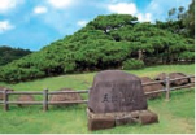Travel Reference
In-Depth Information
Goeda-no matsu (
五枝の松
)
Resembling an enormous bonsai tree, this spectacular specimen of a Japanese black pine (
Pinus thun-
bergii
) has records daing to 1839 but it may be much older than that. It stands 20 feet (6 meters) tall
and has five trunks. It is claimed that the tree was planted in honor of the Ryukyu harvest gods. It is
one of the most famous pine trees in Japan and many songs have been writen about it in Okinawan
folk music.
Almost directly across from the shrine, on the left side of the road going east, you might
just catch out of the corner of your eye a small blue sign:
馬の角
(“Horse's Horn”). What's a
horse's horn? The horn of a unicorn, of course. A left and a right and a left again (follow the
signs) and you'll come to yet another ancient preserved Okinawan house, this one surroun-
ded by a peaceful though heavily overgrown garden. It's a tiny museum, but more often than
not it's closed.
Inside the museum is the usual collection of silk garments, some vintage photographs,
several old ceramics and a few artifacts and other memorabilia. But what this particular
house museum also holds is a small glass-covered wooden case and mounted therein an un-
usual, exceptional object.
Have you ever seen a unicorn's horn? Not many people have. There is a note alongside
explaining that it was a treasured gift bestowed upon the ruler of this house from a visiting
Chinese dignitary. In reality it is thought to be the tusk of a narwhal whale and, indeed, only
a short bit of one. Nevertheless, the spiraled tusk of a narwhal is as rare an item as is the
spiraled horn of a unicorn. As a rule the horn is kept out of sight, hidden away in a storage
credenza, but if you ask the museum's guardian he will open the armoire, unfold the fabric
enclosing the box, and let you have a look. It's not sacred, but it's rare, old and treasured.
You'll see from the guardian's demeanor that the unicorn horn remains a venerated object.
Treat it, and your visit, with respect.
Continuing our drive northeast, in a little less than three-quarters of a mile (1 kilometer)
we'll come to a sign for the Yajagama Cave (
ヤジャーガマ
; Yajā-gama). The cave's name is

